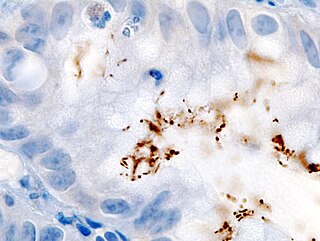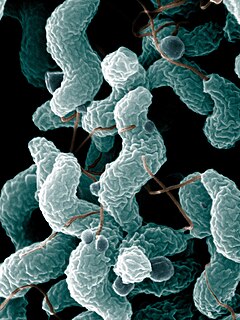
Helicobacter pylori, previously known as Campylobacter pylori, is a gram-negative, microaerophilic, spiral (helical) bacterium usually found in the stomach. Its helical shape is thought to have evolved in order to penetrate the mucoid lining of the stomach and thereby establish infection. The bacterium was first identified in 1982 by the Australian doctors Barry Marshall and Robin Warren. H. pylori has been associated with cancer of the mucosa-associated lymphoid tissue in the stomach, esophagus, colon, rectum, or tissues around the eye, and of lymphoid tissue in the stomach.

Helicobacter is a genus of Gram-negative bacteria possessing a characteristic helical shape. They were initially considered to be members of the genus Campylobacter, but in 1989, Goodwin et al. published sufficient reasons to justify the new genus name Helicobacter. The genus Helicobacter contains about 35 species.

Campylobacter jejuni is one of the most common causes of food poisoning in Europe and in the US. The vast majority of cases occur as isolated events, not as part of recognized outbreaks. Active surveillance through the Foodborne Diseases Active Surveillance Network (FoodNet) indicates that about 20 cases are diagnosed each year for each 100,000 people in the US, while many more cases are undiagnosed or unreported; the CDC estimates a total of 1.5 million infections every year. The European Food Safety Authority reported 246,571 cases in 2018, and estimated approximately nine million cases of human campylobacteriosis per year in the European Union.

Shigella flexneri is a species of Gram-negative bacteria in the genus Shigella that can cause diarrhea in humans. Several different serogroups of Shigella are described; S. flexneri belongs to group B. S. flexneri infections can usually be treated with antibiotics, although some strains have become resistant. Less severe cases are not usually treated because they become more resistant in the future. Shigella are closely related to Escherichia coli, but can be differentiated from E.coli based on pathogenicity, physiology and serology.
Chlamydia muridarum is an intracellular bacterial species that at one time belonged to Chlamydia trachomatis. However, C. trachomatis naturally only infects humans and C. muridarum naturally infects only members of the family Muridae.
Limosilactobacillus reuteri is a lactic acid bacterium found in a variety of natural environments, including the gastrointestinal tract of humans and other animals. It does not appear to be pathogenic and may have health effects.

Gliding motility is a type of translocation used by microorganisms that is independent of propulsive structures such as flagella, pili, and fimbriae. Gliding allows microorganisms to travel along the surface of low aqueous films. The mechanisms of this motility are only partially known.
Lactobacillus gasseri is a species in the genus Lactobacillus identified in 1980 by François Gasser and his associates. It is part of the vaginal flora. Its genome has been sequenced. L. gasseri is a normal inhabitant of the lower reproductive tract in healthy women. It also produces Lactocillin.
Helicobacter hepaticus is a bacterium in the Helicobacteraceae family, Campylobacterales order.

Helicobacter bilis is a bacterium in the Helicobacteraceae family, Campylobacterales order. It is a fusiform bacterium with three to 14 multiple bipolar sheathed flagella and periplasmic fibers wrapped around the cell. It is resistant to cephalothin and nalidixic acid, but sensitive to metronidazole. Like Helicobacter hepaticus, it colonizes the bile, liver, and intestine of mice, and is associated with multifocal chronic hepatitis and hepatocellular tumors.
Helicobacter rodentium is a bacterium in the Helicobacteraceae family, Campylobacterales order. It is a spiral-shaped bacterium with a bipolar, single, nonsheathed flagellum. It is resistant to cephalothin and nalidixic acid. Its type strain is MIT 95-1707. Its name refers to the species first being isolated from mice.
Helicobacter felis is a bacterial species in the Helicobacteraceae family, Campylobacterales order, Helicobacter genus. This bacterium is Gram-negative, microaerophilic, urease-positive, and spiral-shaped. Its type strain is CS1T. It can be pathogenic.
Helicobacter acinonychis is a bacterium in the Helicobacteraceae family, Campylobacterales order. It was first isolated from cheetahs with gastritis, so has been associated with this disease in this particular species and others of its kind. It is Gram-negative, spiral-shaped, and grows under microaerophilic conditions. The type strain is 90-119.
Helicobacter trogontum is a bacterium in the Helicobacteraceae family, Campylobacterales order. It was first isolated from rat intestine. It is Gram-negative, its cells are rod-shaped with pointed ends, and its protoplasmic cylinder is entwined with periplasmic fibers. It is microaerophilic. The type strain is LRB 8581.
Helicobacter cholecystus is a bacterium first isolated from gallbladders of golden hamster with cholangiofibrosis and centrilobular pancreatitis. It is filamentous, Gram-negative, and motile, with a single polar-sheathed flagellum. It is also microaerophilic.
Helicobacter anseris is a bacterium in the Helicobacteraceae family, Campylobacterales order. It is Gram-negative, microaerophilic, spiral to curve-shaped, being first isolated from the faeces of geese.
Helicobacter brantae is a bacterium in the Helicobacteraceae family, Campylobacterales order. It is Gram-negative, microaerophilic, spiral to curve-shaped, being first isolated from the faeces of geese.
Citrobacter rodentium is a Gram-negative species of bacteria. It infects the intestinal tracts of rodents, and infrequently is an opportunistic pathogen in humans.
Helicobacter typhlonius is a Gram-negative bacterium and opportunistic pathogen found in the genus Helicobacter. Only 35 known species are in this genus, which was described in 1982. H. typhlonius has a small number of close relatives, including Helicobacter muridarum, Helicobacter trogontum, and Helicobacter hepaticus, with the latter being the closest relative and much more prevalent.
Helicobacter cetorum is a Gram-negative, microaerophilic, spiral (helical) bacterium that is usually found in the stomachs of whales and dolphins. Based on 16S rRNA sequencing, its genome is very similar to that of Helicobacter pylori in that it can cause gastric disease in these animals. Originally isolated among Atlantic white-sided dolphins and Beluga whales in 2000, H. cetorum has been associated with hemorrhages throughout its entire gastrointestinal tract, but its role has not yet been discovered. Prior to the discovery of H. cetorum, there have not been any other Helicobacter species reported in dolphins.




